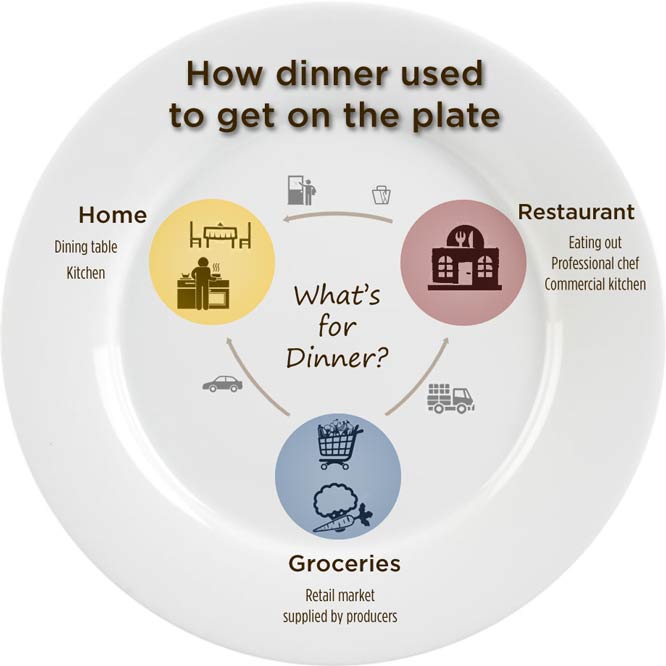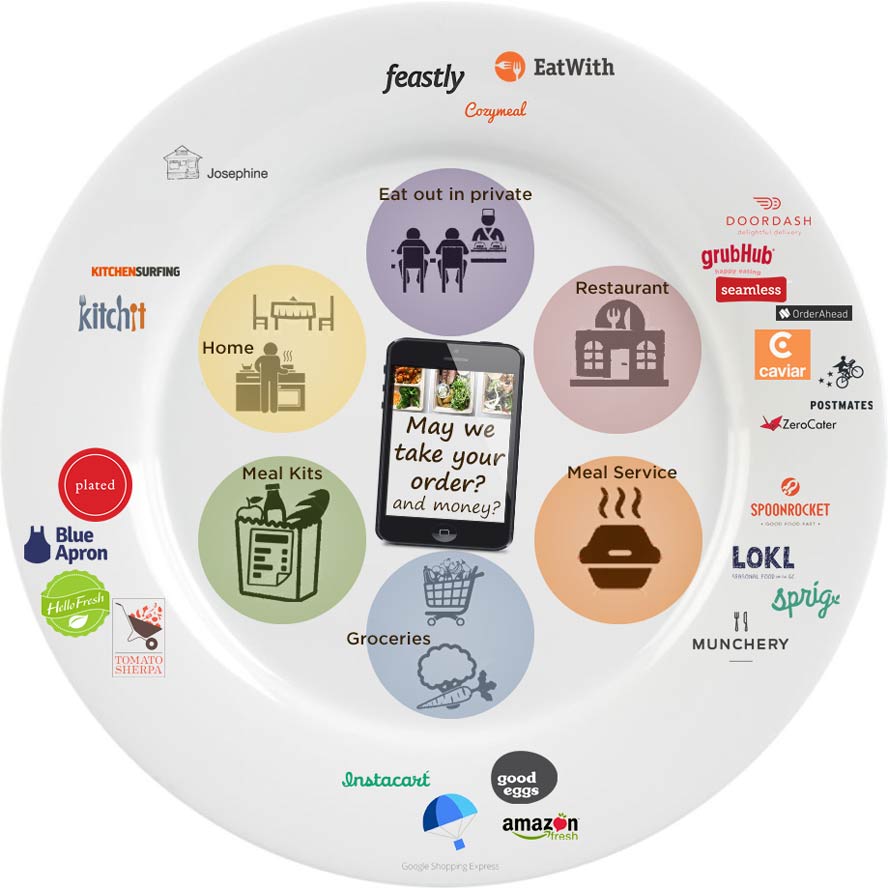"What's For Dinner?"
Of course, there's an app for that.
- By Arno Hesse
Airbnb and VRBO are changing how we travel. Lyft and Uber have definitely disrupted the taxi industry. What about the food business? Will apps and sharing models change our daily routines for getting dinner on the table?
The San Francisco Bay Area has seen a myriad of news services offering bringing dinner to your home, in different stages of readiness. Their offerings are not yet well understood and can be confusing. Let’s shine some light on the landscape of new meal providers. What are their success factors? Are they sustainable?
 First, the three pillars for dinner we have known for generations:
First, the three pillars for dinner we have known for generations:
- Buy food at the grocery.
- Cook at home.
- Eat out or take-out at a restaurant.
These three well-known dinner have changed over the years. Grocery markets now sell more prepared foods than ever, competing with take-out at restaurants. Food trucks have made inroads in the fast-food offerings, offering better quality and specialties, backed by an unbeatable real estate advantage.
New meal services fill in every nuance between the traditional dinner options.
For the purpose of this overview, we’re looking foremost at services that allow a same-day decision to the question “what’s for dinner?”
The offerings tend to different by stage of eat-readiness, location of the meal, and quality differentiators.
Stages of the food provided
- Same-day delivery of groceries, usually unprepared (e.g. Instacart)
- Meal kits with recipes include measured ingredients, sometimes already prepped (e.g. Plated). These services support and promote cooking, an act of food interaction eloquently advocated for by Michael Pollan recently.
- Meal services provide prepared meals based on a limited menu changing on a daily basis. Some have to be heated (e.g. Munchery), others arrived ready to eat (e.g. Sprig). These services typically have their own kitchens.
- Delivery from restaurant: a variation of the well-known pizza taxi, now facilitated via mobile apps and often leaning on the now ubiquitous ridesharing drivers. (e.g. GrubHub)
Location of the food provided
- Pick-up at the kitchen: either at the restaurant, pop-up, or kitchen of a private chef
- Drop-off the work location, to take home after work
- Delivery to the home
Differentiators in quality, sources, and convenience
- Delivery services place a bet on restaurants already known to their markets. (e.g. Caviar)
- Some meal services highlight the pedigree of the chefs creating the meals. (e.g. Munchery)
- New services emphasize the freshness and transparency of the sourced ingredients (e.g. LOKL)
- Others advertise the speed of turnaround (in 10-20 at your curb, e.g. Spoonrocket).
What they all have in common: Front of the House
No matter what the model, all new dinner services provide two features:
- Menu and ordering capability: Typically all providers take orders over the web or via a mobile app. Every provider is keen on the customer information and purchase data.
- Payment processing: Like with Lyft and Uber, all payments are done in the background, separated from the delivery of the goods. It’s is the most effective way for the new middlemen to collect their toll.
Some of the services are nothing but the front of the house. They leave the production and cooking to the traditional providers. Even the delivery is often outsourced to third-party services.
Success drivers and sources for value creation
Are these services viable? Is their food and their business sustainable? To survive, they need to master key capabilities:
Consistent quality. Dinner is a daily repeat memory. Disappointments won’t generate repeat business.
Operational efficiency. Most dinners need to be available in a two-hour window. Success requires a very well-tuned operation for sourcing, prep, cooking, packaging, and delivery. If the services has its own delivery fleet, the density of the delivery spots will be key for survival. The partners for supplies and delivery need to be tightly integrated in the processes.
Safe sources. By its very nature, food fluctuates with the cycles of nature. Reliable quality and food safety require close and preferred relationships with providers. Simplicity and transparency matter.
Strong brand or community involvement. At 4pm, when the dinner question arises, what is service name that first comes to mind? With the trend towards local food, many eaters will be looking for services grounded in local community, wary of “another Starbucks” to feed them.
Will the new meal services empower local producers? Or will they create a few national middlemen?
Naturally, this overview is very simplified and certainly incomplete. Comments are welcome.
Arno Hesse is a co-leader of Slow Money Northern California and founder of Credibles.


